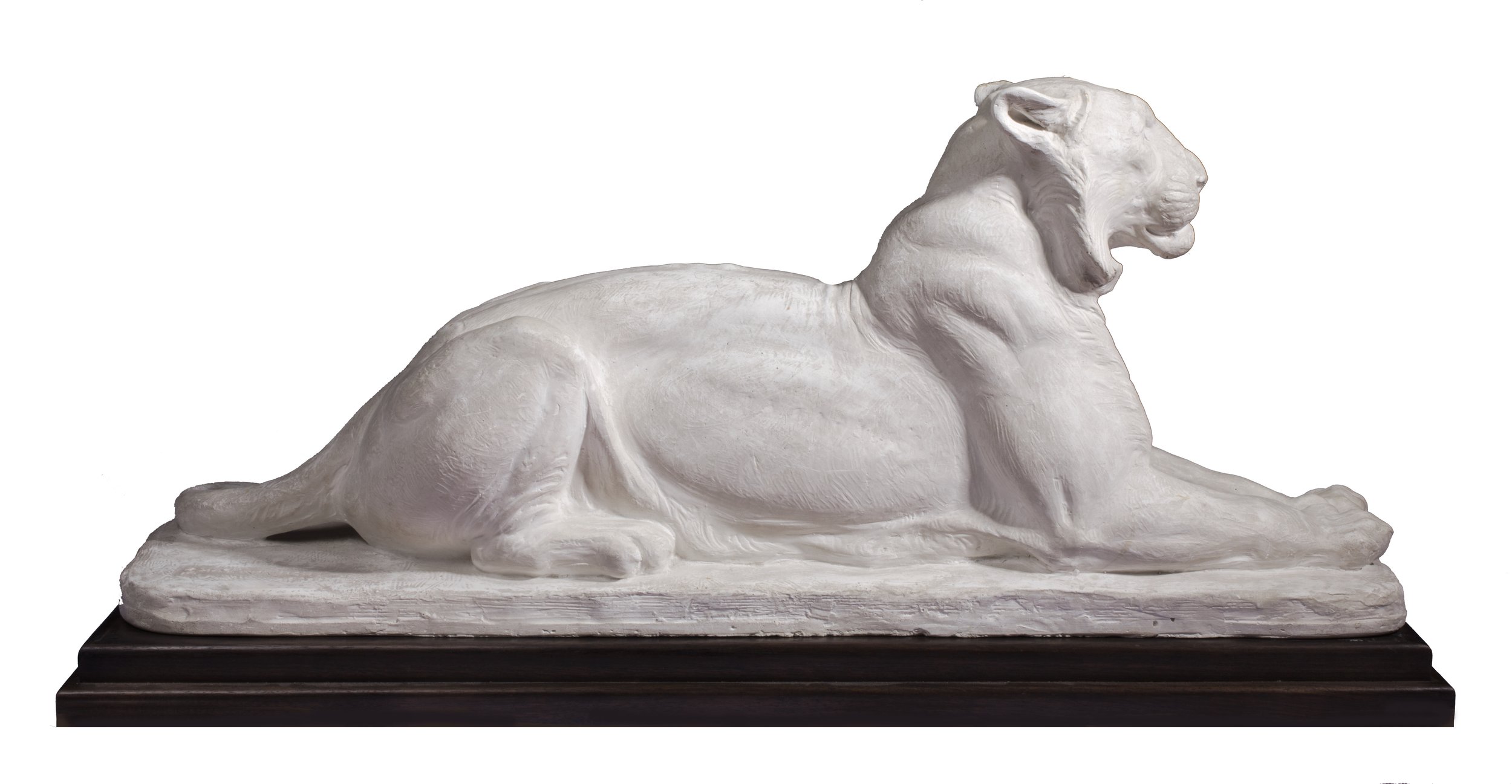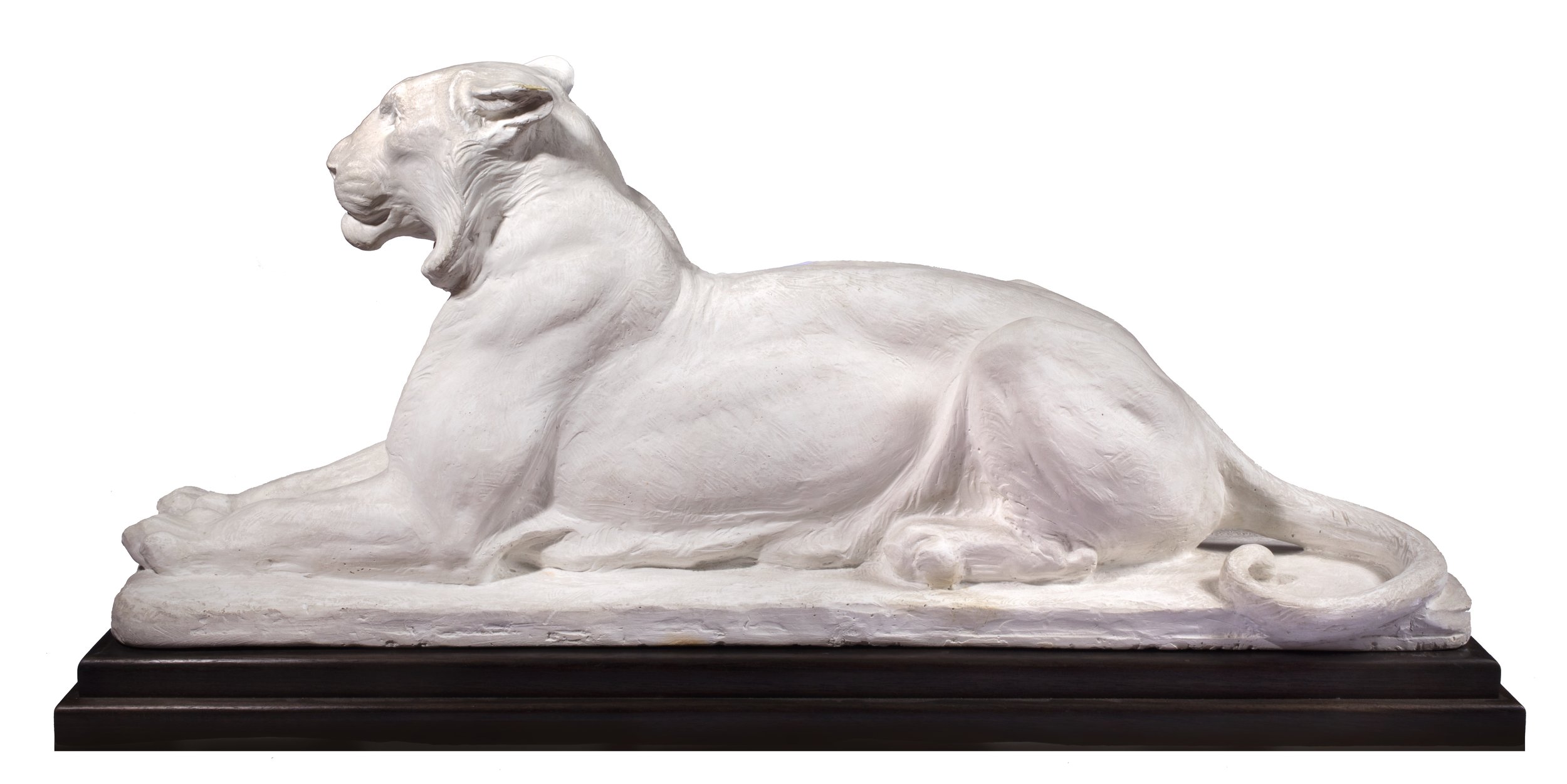



CHARLES R. KNIGHT
(Brooklyn 1874 – 1953 Manhattan)
The Princeton Tiger
Signed and dated at the rear: CHAS. R. KNIGHT / 43
Plaster
14 ½ x 34 x 9 ¼ inches (36.8 x 86.4 x 23.5 cm)
16 ½ x 35 ¾ x 10 ⅛ inches (41.9 x 90.8 x 25.7 cm), including base
Provenance:
The artist; thence by descent to his granddaughter:
Rhoda Knight Kalt; from whom acquired by:
Private Collection, Pennsylvania, 1995–2025.
Literature:
Richard Milner, Charles R. Knight: The Artist Who Saw Through Time, New York, 2012, p. 63.
Charles R. Knight holds a unique place among American painters. As much a zoologist as an artist, he is responsible for the authoritative and dramatic images of our ancient past that have inspired generations of students and adults. Beginning in the 1890s, Knight utilized his extensive knowledge of animal anatomy and his ability to capture motion and behavior of living animals, both in zoos and in the wild, in a collaborative effort with paleontologists to visualize and to illustrate antecedents of current species, pre-historic creatures and early man. Knight’s great murals in this genre are to be found in America’s major natural history museums: the Field Museum in Chicago, the Natural History Museum in Los Angeles, and the American Museum of Natural History in New York City.
Knight’s interest and involvement with wild cats was life-long. Sheets of studies record the artist’s fascination with their habits, activities, and behavior—particularly of tigers, which seem to have held a special place in the artist’s life. Paintings and watercolors of tigers included many varieties, both extant and extinct (such as his celebrated depictions of Smilodon).
Knight had for many years dreamed of sculpting a large bronze statue of a tiger to be placed outside of Princeton University’s football stadium to honor the University’s team, the Princeton Tigers. He sculpted Leaping Tiger (Fig. 1) in 1925 with the hope that funds could be raised to place a bronze version of “heroic size,” in the artist’s words, outside of Stephen Palmer Stadium, which had been donated by Edgar Palmer of the Class of 1903.[i] However, despite the support of Knight’s great sponsor and patron, Henry Fairfield Osborn (1857–1935), the project never materialized.[ii]
Fig. 1. Charles R. Knight, Leaping Tiger, 1925.
In the 1930s Palmer undertook the commercial redevelopment of the center of the town of Princeton in an area along Nassau Street directly across from the University campus. Colonial Revival buildings were constructed around a public square populated with shops, restaurants, residences, and, prominently, a new Post Office and the rebuilt Nassau Inn.
After Edgar Palmer’s death in 1943 his family commissioned Knight to sculpt a monumental tiger to be placed at the center of Palmer Square, both as an homage to the University’s mascot and as a memorial to Palmer. Unlike the fierce adversary of the 1925 tiger, the Palmer Square tiger would depict the cat in alert repose, in an attitude similar to that of Knight’s 1923 painting The River of Time (Fig. 2), which Osborn had earlier commissioned to decorate the old Nassau Inn.[iii]
Fig. 2. Charles R. Knight, The River of Time, Private Collection.
The present work is the original plaster maquette for the Palmer Square Tiger. First modelled in clay, then cast by the artist in plaster detailed by him, the tiger was then enlarged approximately three times at the Roman Bronze foundry in New York. At over eight feet in length, the finished bronze was dedicated in 1944 (Fig. 3).[iv]
Fig. 3. Charles R. Knight, Tiger, Palmer Square, Princeton, New Jersey.
Since then the sculpture has become both a landmark of the town and a symbol of the University—one that resonates with students, alumni, and visitors alike. Writing to Charles R. Knight some years after the sculpture’s dedication, Palmer’s son-in-law commented:
“Some works of art deteriorate with age and take on the appearance of obsolescence—not so however with the Knight Tiger which adorns Palmer Square at Princeton, New Jersey… I had the pleasure of spending yesterday in Princeton, and of… observing it carefully after these years have gone by. I just wanted you to know that it has taken on a dignity which is really inspiring to the people of Princeton, and, of course to the students it is an emblem symbolic of energy, courage, perseverance, and success, not alone in athletics, but in all activities.”[v]
A concrete version of the Palmer Square Tiger, said to have been used in the casting process, descended in Palmer’s family as a garden ornament. In 1983 it was given to the University, restored, and placed in the lobby of Jadwin Gymnasium at Princeton.[vi]
[i] Leaping Tiger, 1925. Bronze; 68 × 88 × 40.6 cm, Princeton University Art Gallery, Princeton University, presented by Knight Steel and Rhoda Kalt Steel, grandchildren of the artist, in memory of Prof. Henry Fairfield Osborn, 1877. Other casts have appeared on the art market.
[ii] Osborn was a distinguished geologist and paleontologist—a Professor of Zoology, first at Princeton and later at Columbia University, and, from 1891, Curator of Vertebrate Paleontology at the American Museum of Natural History. An influential and independently wealthy man, Osborn became President of the American Museum in 1908, serving in that capacity until his retirement in 1933. Osborn was a Princeton alumnus (Class of 1877) and in 1923 conceived of Knight’s painting a large canvas of a tiger for display at the Nassau Inn in Princeton.
[iii] The painting was returned to Osborn’s family following the closure of the old Nassau Inn in 1935. Later in a private Florida collection, it was sold by Robert Simon Fine Art in 2013.
[iv] The accompanying plaque reads “In Memory of /Edgar Palmer / whose vision and generosity / planed and built this square / for Princeton / which he so loved / Erected by his friends / 1944.”
[v] Letter of Eugene Watson to Charles R. Knight, 1951 quoted by Richard Milner, Charles R. Knight: The Artist Who Saw Through Time, New York, 2012, p. 63.
[vi] See: https://princetoniana.princeton.edu/campus/landmarks/tigers/devereux-tiger, accessed 26 April 2025.





